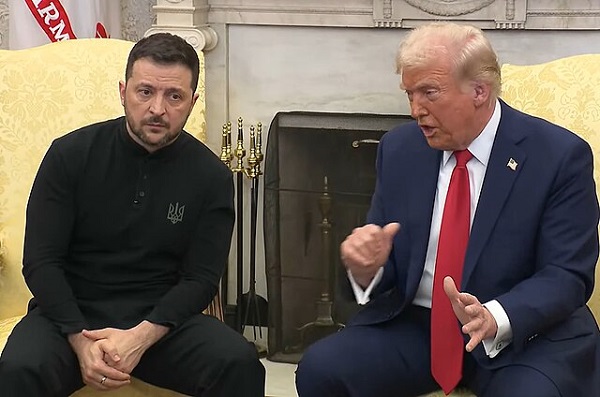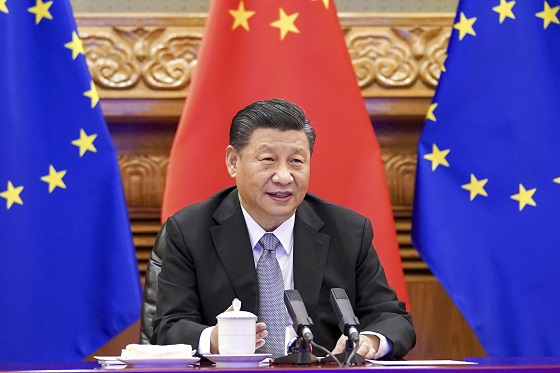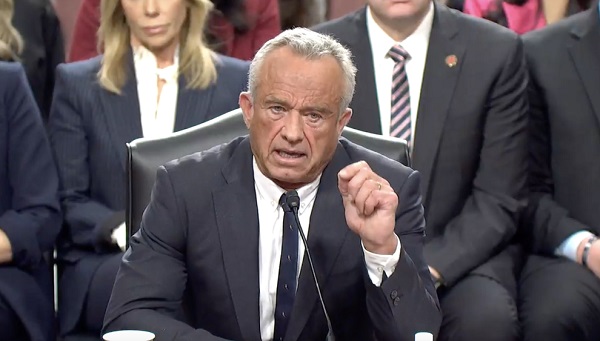conflict
Ukraine And Russia Scramble To Make Territorial Gains In Anticipation That Trump Will Push For Peace Deal

 From the Daily Caller News Foundation
From the Daily Caller News Foundation
Ukraine and Russia are both vying to make territorial gains ahead of President-elect Donald Trump’s inauguration and his expected push for a peace deal.
Trump has said on multiple occasions that he would bring a swift end to the war, relying on his relationships with both Ukrainian President Volodymyr Zelenskyy and Russian President Vladimir Putin and his ability to negotiate with both. In anticipation that Trump will broker a peace settlement in short order, both Russia and Ukraine are making potential last-ditch efforts to grab territory for the other that they could possibly use as leverage during negotiations, according to The Wall Street Journal.
“They’re assaulting all the time—morning, day, night,” a Ukrainian battalion commander told the WSJ.
One current flashpoint is the Kursk region of Russia, which Ukrainian forces seized part of during an invasion over the summer. Russian forces are desperately vying to take back the territory, according to the WSJ. Moscow has deployed roughly 45,000 troops to the region, and in recent weeks has taken back half of it. North Korea has additionally deployed 10,000 troops to Kursk to aid Russian forces.
Meanwhile, Ukraine has been making use of U.S.-provided long-range missiles to strike targets deep inside Russia, the first time Ukraine has been allowed to do so after two years of war. President Joe Biden’s decision to let Ukraine use the missiles puzzled some national security experts, given the national security risks.
There’s some concern in Kyiv that Trump will approach U.S. support for Ukraine differently than Biden has, and that Trump’s bid to end the war could end up benefiting Russia, according to the WSJ. Ukraine believes Russia wants to retake Kursk before Trump is inaugurated.
“It’s the best Ukrainian forces against the best Russian forces,” a Ukrainian sergeant fighting in Kursk told the WSJ. “At this rate, I see no reason for us to withdraw.”
Russia is losing roughly 1,000 men a day in the fight to retake Kursk, some Ukrainian troops told the WSJ. Russia has lost an estimated 700,000 fighters total since the war began.
Ukraine is betting that if it can hold onto Kursk, it can use the region as leverage in future ceasefire negotiations with Russia, according to the WSJ.
“The Ukrainian strategy there is to hold on to it as a bargaining chip and obtain a favorable attrition ratio vis-à-vis the Russians,” Vienna-based military analyst Franz-Stefan Gady told the WSJ. While it would be difficult for Ukraine to hold on to Kursk, Gady said, “I think the Russians will have a tough fight.”
But the sentiment among some Ukrainian soldiers is wavering, with some feeling anger or confusion toward the Kursk operation and whether it was worth the cost, according to the WSJ. And Moscow hasn’t stopped throwing men toward the frontlines. Ukraine has suffered from a lack of manpower since the war began, and fighters don’t have access to the same military or communication equipment that Russia does.
“I think they’ll eventually push us back,” the Ukrainian battalion commander told the WSJ. “They add more power and more resources, and they have a goal to reach the border at any cost, so they will do it.”
conflict
Trump tells Zelensky: Accept peace or risk ‘losing the whole country’

 MxM News
MxM News
Quick Hit:
President Donald Trump warned Ukrainian President Volodymyr Zelensky that he risks losing Ukraine entirely if he continues resisting a peace settlement. Trump said Moscow is ready for peace, but Kyiv’s refusal to recognize Crimea as Russian territory could derail the effort.
Key Details:
- Trump said Zelensky “can have Peace or… lose the whole Country” and claimed Russia is ready to make a deal.
- Zelensky reiterated Ukraine’s refusal to recognize Russia’s occupation of Crimea, a key sticking point in current peace talks.
- White House press secretary Karoline Leavitt said Trump is frustrated and warned peace efforts may end if no deal is reached this week.
Diving Deeper:
President Trump issued a blunt warning to Ukrainian President Volodymyr Zelensky on Wednesday, saying the Ukrainian leader must choose between accepting peace or facing the collapse of his nation.
“He can have Peace or… fight for another three years before losing the whole Country,” Trump posted on Truth Social. The statement followed Zelensky’s firm declaration that Ukraine “will not legally recognize the [Russian] occupation of Crimea,” a stance at odds with a proposed peace plan under discussion in London between U.S., British, and European officials.
Trump blasted Zelensky’s comment as damaging, declaring, “Crimea was lost years ago under the auspices of President Barack Hussein Obama, and is not even a point of discussion.” The president added that such rhetoric undermines delicate peace negotiations.
Speaking from the Oval Office, Trump said, “I think Russia is ready,” referring to a peace deal, but questioned whether Ukraine is. Kyiv reportedly signed on to a Trump-proposed ceasefire more than a month ago. Trump hinted that progress has been stymied by Zelensky’s reluctance to compromise.
Despite Russian officials signaling a desire to prolong negotiations—with Kremlin spokesman Dmitry Peskov dismissing Trump’s efforts as “futile”—Trump maintained optimism, stating, “I think we have a deal with Russia… we have to get a deal with Zelensky.”
White House press secretary Karoline Leavitt said Trump’s patience is wearing thin. “President Zelensky has been trying to litigate this peace negotiation in the press, and that’s unacceptable,” she said, calling for closed-door diplomacy. “The American taxpayer has funded billions… enough is enough.”
Trump, 78, has consistently criticized Obama for allowing Russia’s 2014 annexation of Crimea to go unanswered. Now, under the Trump administration’s push for peace, a senior official revealed the U.S. is considering recognizing Crimea as Russian territory—a reversal of longstanding American policy based on the 1940 Welles Declaration.
Still, Trump refrained from criticizing Vladimir Putin directly, instead blaming Zelensky for inflammatory statements. “He has nothing to boast about!” Trump said, referencing a heated Feb. 28 Oval Office exchange with Zelensky and Vice President JD Vance.
“I have nothing to do with Russia,” Trump wrote, “but have much to do with wanting to save… five thousand Russian and Ukrainian soldiers a week.”
Trump warned that time is running out: “We are very close to a Deal, but the man with ‘no cards to play’ should now, finally, GET IT DONE.”
With London talks underway and pressure mounting, officials hinted that if no agreement is reached this week, the U.S. could walk away from its efforts in Eastern Europe. Asked whether Trump is ready to give up, Leavitt said, “Not by the end of the day today… but the President… needs to see this thing come to an end.”
conflict
Marco Rubio says US could soon ‘move on’ from Ukraine conflict: ‘This is not our war’

From LifeSiteNews
Secretary of State Marco Rubio is calling the EU/UK bluff here because he knows without the U.S. the EU/UK will not commit to fight Russia.
Secretary of State Marco Rubio spoke to reporters in Paris on April 18 about the prolonged peace talks between Russia and Ukraine. However, a frustrated Rubio warned that the U.S. could “move on” from its involvement in negotiations to end the war if no progress is made “within a matter of days and weeks.” That’s the mainstream media narrative.
The non-pretending summary is that Ukraine, France, Great Britain, the EU, NATO, et al are all trying to retain their interests in the conflict. Russia has simple terms, but the war machinery controlled by the intel apparatus (CIA and EU) and the financial stakeholders in the EU region are unhappy. A frustrated Secretary Rubio says, make up your mind, if no deal – we’re done.
Having followed this very closely, here’s what “we’re done” likely means.
President Trump ends the U.S. side of the proxy war. President Trump pulls back all support for Ukraine, stops sending money, weapons, and, to the extent he can, intelligence to Ukraine. This opens the door for Russia to go full combat as the ground thaws, without concern for U.S. to engage.
The EU will have to step up with funding, intelligence, and war material to continue supporting Ukraine. Rubio is calling the EU/UK bluff here because he knows without the U.S. the EU/UK will not commit to fight Russia.
Remember that if no one does anything, Russia has already gained the ground they want and will just continue grinding western Ukraine to ever-expanding rubble. Factually, doing nothing is a big win for Russia, especially if Trump withdraws.
Reprinted with permission from Conservative Treehouse.
-

 Business2 days ago
Business2 days agoTrump: China’s tariffs to “come down substantially” after negotiations with Xi
-

 Business2 days ago
Business2 days agoTrump considers $5K bonus for moms to increase birthrate
-

 2025 Federal Election2 days ago
2025 Federal Election2 days agoPolice Associations Endorse Conservatives. Poilievre Will Shut Down Tent Cities
-

 Business2 days ago
Business2 days agoChinese firm unveils palm-based biometric ID payments, sparking fresh privacy concerns
-

 COVID-192 days ago
COVID-192 days agoRFK Jr. Launches Long-Awaited Offensive Against COVID-19 mRNA Shots
-

 Business23 hours ago
Business23 hours agoIs Government Inflation Reporting Accurate?
-

 2025 Federal Election1 day ago
2025 Federal Election1 day agoConservatives promise to ban firing of Canadian federal workers based on COVID jab status
-

 2025 Federal Election1 day ago
2025 Federal Election1 day agoCarney’s Hidden Climate Finance Agenda





